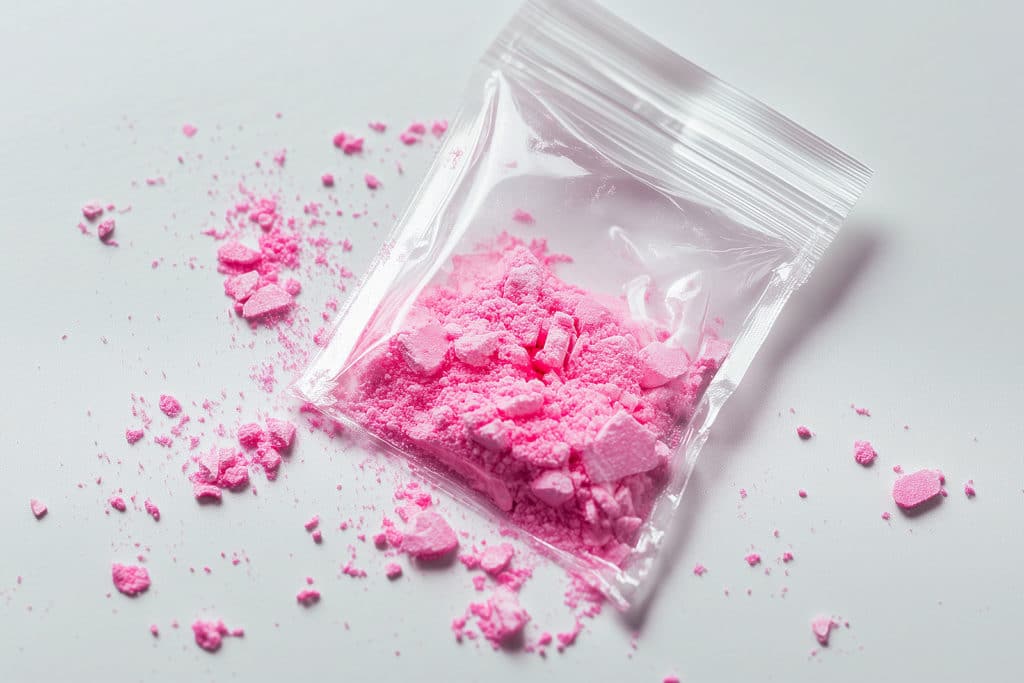Today’s street drug scene is more dangerous than ever. Not only is there a spectrum of new, dangerous, and addictive drugs in circulation, but they are at least occasionally laced with Fentanyl, which can be deadly in minuscule doses. But this is just a sample of the scope of this problem. Here are just a few of the latest and most devastating street drugs that are known to be in circulation now:
- Flakka: Stimulant
- Bath salts: Stimulant
- Ecstasy: Hallucinogen
- Krokodil: Opioid
- Spice: synthetic cannabinoid
Sadly, this is just the tip of the iceberg when it comes to the full scope and number of these new, powerful designer drugs. Many of the most addictive of these are less poisonous yet highly addictive. This creates long-term addictive cycles that can be as or more difficult to break than those associated with heroin or methamphetamine.

Here, we are concerned with the latest street intoxicant known as Tucibi, Tuci, Tusi or “pink cocaine.” Tucibi is difficult to classify because it is a mix of two or more drugs of abuse, such as some of those listed above, and an aromatic pink powder. What this means for users is that you never know what’s in it. It can cause unpredictable psychoactive effects. Of course, when it contains some of the more potent street drugs like Fentanyl, it can be deadly in a single use.
According to the Ohio Recovery Center, Tucibi is: “[…] imported from South America, Tucibi is often neither cocaine nor the psychedelic drug known as “2C-B” or Nexus. The “2C-B” is not Tucibi (pink cocaine). It is a mixture of pink powder with various drugs of abuse (mixture of cheaper substances like ketamine and ecstasy), making it unpredictable, dangerous, and addictive.
The drug known as 2C-B is a designer psychedelic drug that also comes in the form of a pink powder. Tucibi is the mixed and unpredictable form described above.
Table of Contents
- Origin and History of Tucibi
- The Basics of Pink Cocaine
- Pink Cocaine and Cocaine
- The Chemistry of Tucibi
- Small Doses and Street Names
- Usage and Effects of Tucibi
- The Popularity of Tucibi
- Risks and Dangers of Tucibi Use
- Tucibi and the Law
- Treatment, Rehabilitation, Prevention, and Education
- Addiction Treatment Success Rates
- Conclusion
Origin and History of Tucibi

The original psychedelic form Tucibi is based on hearkens back to 1974 and was first synthesized by Alexander Shulgin. The modern form known as Tucibi is a recent knock-off version. While the original is both an hallucinogen and stimulant, the modern variant could be either something else, or a conglomeration of whatever a drug dealer happens to have on hand.
Repetitive use of Tucibi is usually a product of other drug habits. Often, the addicted person is seeking something similar to cocaine, heroin, or some other drug of choice and accepts Tucibi as a substitute. This can lead to repeated use of this drug, which can lead to unpredictable behavior and sometimes exposure to deadly substances.
The unpredictable nature of this type of drug makes it especially dangerous for persons suffering from addiction.
The Basics of Pink Cocaine
Pink cocaine, colloquially known as Tucibi, is a synthetic drug that has gained notoriety in recent years. It is a compound derived from a mixture of MDMA, amphetamine, LSD, and other synthetic drugs, resulting in a potent and unpredictable substance. Tucibi is often marketed as a designer drug, mimicking the effects of cocaine but with potentially more intense and dangerous outcomes. Its pink hue distinguishes it from traditional cocaine, hence the moniker “pink cocaine.”
Pink Cocaine and Cocaine
While both pink cocaine and traditional cocaine affect the central nervous system, they differ in composition and potency. Pink cocaine’s cocktail of MDMA, amphetamine, LSD, and other synthetic drugs sets it apart from the pure form of cocaine. This blend can lead to heightened euphoria, altered perceptions, and increased energy levels similar to those experienced with MDMA or amphetamine use. However, the inclusion of LSD can introduce hallucinogenic effects not typically associated with cocaine.
The Chemistry of Tucibi

The original drug known as 2C-B is 4-Bromo-2,5-dimethoxyphenethylamine and is known as a hallucinogen, stimulant, empathogen, and entactogen. An empathogen is designed to “create empathic states,” not unlike Ecstasy. An entactogen is a drug whose name means to “produce a touching within.” Its purpose is to bring a person into contact with or awareness of inner states.
The original intention of 2C-B was therapeutic, and it led to the clinical use of drugs like ecstasy in marriage counseling. But like ecstasy, it has become a drug of abuse and is strictly controlled.
But, as mentioned above, 2C-B has inspired the creation of the designer drug known as Tucibi (our subject here), which is an admixture of street drugs, including cocaine, ecstasy, heroin, meth, and others, sometimes including Fentanyl. In reality, Tucibi is really a category of drug rather than a distinct drug in its own right.
As such, the side effects and chemistry of Tucibi cannot be classified or predicted. Its place as a street drug and substance of abuse is largely cultural in nature. In most cases, a person whose drug of choice is cocaine, heroin, or others will take Tucibi as a cheap alternative or when the drug of choice is unavailable.
This makes its use especially dangerous, leading people to take on effects of pink cocaine that may not be expected or prepared for. Further, its use creates a situation where the user is vulnerable to being given more dangerous drugs like Fentanyl. For these reasons, taking this pink cocaine represents a grievously deadly form of addictive behavior.
Users can even become addicted to the sensation of risk that comes through what has been called a chemical version of “Russian Roulette.” Because of this cultural use phenomenon surrounding pink cocaine, the use of this type of drug is considered to be indicative of a severe phase of the addiction process, making treatment an immediate necessity.
Small Doses and Street Names
Pink cocaine is often distributed in small doses due to its potency and potential for adverse reactions. Street names for the drug vary depending on the region and local vernacular. Some common aliases include “pink lady,” “rosa,” or simply “pink.” Despite its colorful appearance, the drug is typically encountered as a white powder, similar in appearance to traditional cocaine, further complicating detection and regulation efforts.

Usage and Effects of Tucibi
Upon ingestion, pink cocaine acts as a controller substance, affecting neurotransmitters such as dopamine, serotonin, and phenylethylamine. These neurotransmitters play crucial roles in mood regulation and perception. The drug’s stimulant properties can elevate heart rate, blood pressure, and mental alertness, while also inducing feelings of euphoria and heightened sensory experiences. However, excessive consumption or impurities in the substance may lead to adverse effects on mental health and physical well-being.
The Popularity of Tucibi
The popularity of this class of drug/drug-taking can be attributed to the fact that it appeals to two classes of people; those in the late stages of a drug abuse habit and those who are new to drug-taking.
Sadly, the first of these two groups is a rapidly growing category. Due to inflation, job losses, and other disruptions to the job market, more and more people are finding themselves turning to drugs. Further, the opioid crisis feeds the swelling numbers of this group by funneling more and more people into opioid addiction.
The second group of inexperienced, naive drug users includes children, young adults, and anyone who develops an interest in drug experimentation. Like ecstasy, Tucibi has become known as a party drug. Like many drugs of this kind, it is exceptionally dangerous. Because of the variable nature of the contents of Tucibi, it can be deadly the first time it is used.

Tucibi was considered novel in 2022, and its rise may be partly attributable to the COVID-19 pandemic. With scores of people isolated to their homes, drug use became a more attractive option, and those with little experience obtaining street drugs could assemble a batch of “pink cocaine” from a variety of more easily obtainable products.
At the beginning of its rise to popularity, it was largely confined to use by teens and young adults. But as the culture surrounding this type of drug developed, it has become a drug of last resort for addiction sufferers in the advanced stages of the abuse cycle.
The media, frankly, has not been a positive influence when it comes to pink cocaine as this type of drug and drug abuse behavior has been glamorized in television and movies, as drugs of abuse often are.
Synthetic Drugs and Drug Traffickers
Pink cocaine’s emergence highlights the ever-evolving landscape of synthetic drugs and the ingenuity of drug traffickers. By synthesizing various compounds, traffickers create new substances to capitalize on market demand, particularly within rave and club drug scenes. However, the lack of regulation and oversight raises concerns about the purity and safety of these substances. Additives used in the manufacturing process may pose additional health risks to users.
This type of drug and drug abuse behavior has been glamorized in television and movies, as drugs of abuse often are.
Risks and Dangers of Tucibi Use
The dangers of using drugs of this kind are difficult to calculate. The fact that this drug could literally contain anything makes the danger incalculable. This is why we prefer to think of pink cocaine as a type of drug-taking behavior rather than as a drug itself. Taking it exhibits either naivete about the dangers of street drugs or an advanced stage of the addiction process.
Tucibi and the Law
Tucibi is most popular in South America and Europe. In both of these regions, law enforcement is vigilant in their response to alleged samples of this type of drug. As law enforcement in the United States becomes more aware of this class of drug-taking behavior, they are becoming more vigilant about it as well.

At the time of this writing, all of the drugs likely to be contained in a sample of pink cocaine are illegal and strictly controlled. Tucibi itself is illegal in most of Europe, and Canada is poised to legislate against it soon as well.
The challenge to law enforcement lies in the fact that Tucibi, or pink cocaine itself, does not exist as a drug. Therefore, it is possible to create a batch of “Tucibi” from harmless and legal household items. This slows legal proceedings since the contents of these substances can be difficult to determine.
As always, those who use this type of drug should be much more concerned about the potential health risks and death that can result than about what law enforcement may or may not do in response.
Treatment, Rehabilitation, Prevention, and Education
As stated, using Tucibi is considered by the addiction treatment community to be a very serious and dangerous form of drug abuse. The treatment of choice in all cases depends on the person themselves, their chosen drug of abuse, and the stage of addiction. As mentioned, Tucibi users tend to come from either new drug experimenter groups or long-time addiction sufferers who are close to hitting bottom.
As always, it is the desire to recover on the part of the addicted person that matters most in determining the odds of success. Often, new drug users only need to be shown how dangerous Tucibi is. For others, a lifetime of recovery support is necessary.
Current Treatment Strategies
Treatment phases/modalities for Tucibi users include:
- Medical drug detox
- Inpatient and outpatient treatment
- Treatment initiation
- Replacement therapy
- Group therapy
- Alternative and spiritual treatment/counseling
- Individual cognitive behavioral therapy
- Group and individual support
- Community-based support systems
- Ongoing supportive abstinence maintenance
Addiction Treatment Success Rates
According to American Addiction Centers, just 25% of people treated for addiction disorders avoid relapse in their first year of recovery. Of course, these numbers do not apply to the motivated individual who is determined to achieve a healthy, normal life.

For these individuals, success is not guaranteed, but the odds of success are better than 90%.
Conclusion
The rise of Tucibi is an artifact of massive cultural change on too many levels to discuss fully here. Tucibi itself is not a true drug, but a mix of drugs ranging from moderately to extremely dangerous. For this reason, anyone who uses Tucibi is strongly encouraged to seek treatment immediately.
In time, this drug trend can be expected to lose prominence. It will be replaced by some other drug fad, which will also certainly be dangerous and indicative of a person at serious personal risk.
If you or someone you love has used Tucibi, please consider consulting addiction recovery professionals as soon as possible. Tucibi taking is called the Russian Roulette of drug experimentation for a good reason.
Get in touch today to learn more.
FAQ
Is “Russian Cocaine Mix” the same as Pink Cocaine or Tucibi?
References
- https://thetab.com/uk/2022/07/20/everything-you-need-to-know-about-tuci-the-party-drug-people-are-calling-pink-cocaine-263082
- https://www.drugs.com/fentanyl.html
- https://www.webmd.com/mental-health/addiction/street-drugs-risks
- https://www.recoveryohio.org/cocaine/pink-cocaine/
- https://thetab.com/uk/2022/07/20/everything-you-need-to-know-about-tuci-the-party-drug-people-are-calling-pink-cocaine-263082
- https://americanaddictioncenters.org/rehab-guide/success-rates-and-statistics
Suggested Reading
- The Tucibi (2C-B): the drug of high society: https://en.psychologyinstructor.com/the-tucibi-2c-b-the-drug-of-high-society/
- 5 Forgotten Drug Fads: https://www.mentalfloss.com/article/55075/5-forgotten-drug-fads



